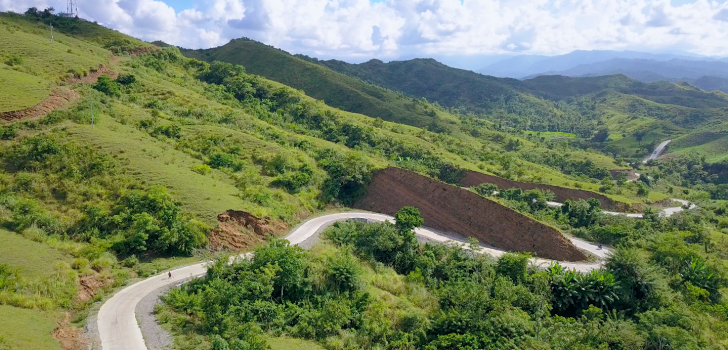 Kalinga FMR. At 70-percent physical completion, the 15.8-kilometer Bulanao–Amlao farm-to-market road (FMR) in Tabuk City, Kalinga already delivers intended benefits to both farming and non-farming households within its influence area. The P196.21-million FMR is among the 387 infrastructure subprojects worth P19.75 billion approved for implementation under the Department of Agriculture's Philippine Rural Development Project (DA-PRDP). With an additional P15.56 billion-worth of proposed subprojects in the PRDP's pipeline, the DA is now seeking an additional $450-million financing from the World Bank for the PRDP's expansion. (Photo by PRDP North Luzon PSO InfoACE Unit)
Kalinga FMR. At 70-percent physical completion, the 15.8-kilometer Bulanao–Amlao farm-to-market road (FMR) in Tabuk City, Kalinga already delivers intended benefits to both farming and non-farming households within its influence area. The P196.21-million FMR is among the 387 infrastructure subprojects worth P19.75 billion approved for implementation under the Department of Agriculture's Philippine Rural Development Project (DA-PRDP). With an additional P15.56 billion-worth of proposed subprojects in the PRDP's pipeline, the DA is now seeking an additional $450-million financing from the World Bank for the PRDP's expansion. (Photo by PRDP North Luzon PSO InfoACE Unit) DA to rank infra projects for funding under the expanded PRDP
The Department of Agriculture (DA) will be using a prioritization scheme for pipelined infrastructure development proposals under the Philippine Rural Development Project (PRDP) to maximize the socio-economic impacts of the anticipated $170-million or P7.90-billion (at P46.5: $1) additional financing from the World Bank.
The $170-million loan, targeted to be utilized in 2018, would be first tranche of the $450-million additional financing that is being sought by the DA for the PRDP’s expansion. With this supplementary assistance from the Bank, the Department aims to cover part of the pipelined subprojects that cost around P15.56 billion.
DA Undersecretary Ariel Cayanan said that the prioritization scheme will also help the DA rationalize the programming and budgeting process of the PRDP’s infrastructure development component, considering funding constraints.
“The pipelined subprojects—our “healthy” pipeline as we call it—have already complied with the requirements of the PRDP such as feasibility study, detailed engineering design, and social and environmental safeguards but as we are currently challenged by limited budget, the best way to approach this is to fund the best proposals based on a set of criteria,” Cayanan said.
“With this scheme in place, we stick to technical and socio-economic viability of subprojects, avoiding political intervention. We also also ensure the equitable distribution of our interventions,” Cayanan added.
The scheme likewise aims to incentivize good-performing local government units (LGUs) and diversify infrastructure subprojects as majority of the Project’s current infrastructure development portfolio are farm-to-market roads (FMRs).
Top priority on first-timer LGUs
Cirilo Namoc, the PRDP’s national deputy project director said that LGUs with no approved subprojects but have signified interest and commitment in the Project by submitting proposals will be accommodated and given top consideration under the prioritization system.
While the PRDP has received sizeable number of subproject proposals especially infrastructure, there are still provinces that have yet to access assistance from the Project. To date, there are still 9 of 81 targeted provinces that have yet to receive financial assistance from the PRDP.
Namoc added that proposals must be linked to the approved Provincial Commodity Investment Plan (PCIP), otherwise these will be deferred until the required document has been produced.
“Proposals satisfying the two conditions will automatically be placed on top of the priority list and will be exempt from all succeeding assessments,” Namoc added.
He clarified, however, that only subproject per LGU will be given automatic priority for review. In case of multiple proposals, the rest will be subjected to prioritization.
Potable water system (PWS) proposals, on the other hand, will be exempted from the PCIP-link criterion as PWSs are not identified as intervention to directly boost agricultural productivity but to improve access of farming or fishing communities to safe drinking water.
Proposals that are not automatically prioritized must satisfy additional criteria to pass the initial screening and will again be subjected to the succeeding prioritization steps.
Additionally, proposals of LGUs with unresolved grievances relating to non-conformance to PRDP procurement and finance guidelines will be put on hold until the grievances have been settled.
LGU performance, subproject type
Proposals from LGUs with previously approved applications will be subjected to further prioritization, which will consider the LGU’s performance in its past engagement with the PRDP and the type of the subproject being proposed.
More points will be given to LGUs proven to have conformed with the PRDP standards on procurement, disbursement, transparency, and social and environmental safeguards, among others. Similarly, non-FMR subprojects such as communal irrigation and potable water systems will be given more priority.
FMRs that are projected to provide significant socio-economic benefits will be prioritized and will be given points based on benefit-cost ratio, road influence area density and number of farming/fishing households, among others.
Bonus: Climate resilience
In support of the Risk Resiliency and Sustainability Program of the Climate Change Cabinet Cluster, the Project has incorporated climate resiliency criteria into the prioritization scheme.
Ten bonus points will be provided to the proposals of the provinces located within identified high-risk and vulnerable water basins in the country, including Apayao, Zambales, Negros Oriental, Eastern Samar, Samar, Compostela Valley, North Cotabato, Sarangani, Sultan Kudarat, Surigao del Norte, Surigao del Sur, Dinagat Islands, Maguindanao and Lanao del Sur.
All proposals falling under the automatic priority category and those ranked based on the prioritization criteria will still be subject to further technical review. ### (Jan P. Dacumos, NPCO InfoACE Unit)
